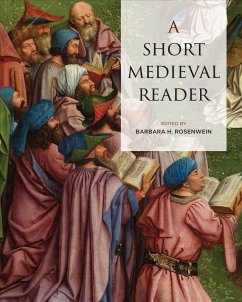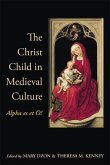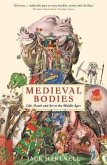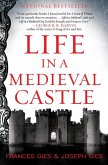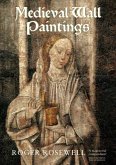- Broschiertes Buch
- Merkliste
- Auf die Merkliste
- Bewerten Bewerten
- Teilen
- Produkt teilen
- Produkterinnerung
- Produkterinnerung
Curated by best-selling author Barbara H. Rosenwein, A Short Medieval Reader offers an exceptionally alluring and affordable set of primary sources for understanding the Middle Ages.
Andere Kunden interessierten sich auch für
![The Christ Child in Medieval Culture The Christ Child in Medieval Culture]() Mary DzonThe Christ Child in Medieval Culture50,99 €
Mary DzonThe Christ Child in Medieval Culture50,99 €![The Livery Collar in Late Medieval England and Wales The Livery Collar in Late Medieval England and Wales]() Matthew J. WardThe Livery Collar in Late Medieval England and Wales35,99 €
Matthew J. WardThe Livery Collar in Late Medieval England and Wales35,99 €![Medieval Bodies Medieval Bodies]() Jack HartnellMedieval Bodies12,99 €
Jack HartnellMedieval Bodies12,99 €![The Bright Ages The Bright Ages]() Matthew GabrieleThe Bright Ages19,99 €
Matthew GabrieleThe Bright Ages19,99 €![Life in a Medieval Castle Life in a Medieval Castle]() Joseph GiesLife in a Medieval Castle17,99 €
Joseph GiesLife in a Medieval Castle17,99 €![Art in England Art in England]() Sara N. JamesArt in England85,99 €
Sara N. JamesArt in England85,99 €![Medieval Wall Paintings in English & Welsh Churches Medieval Wall Paintings in English & Welsh Churches]() Roger RosewellMedieval Wall Paintings in English & Welsh Churches43,99 €
Roger RosewellMedieval Wall Paintings in English & Welsh Churches43,99 €-
-
-
Curated by best-selling author Barbara H. Rosenwein, A Short Medieval Reader offers an exceptionally alluring and affordable set of primary sources for understanding the Middle Ages.
Produktdetails
- Produktdetails
- Verlag: University of Toronto Press
- Seitenzahl: 258
- Erscheinungstermin: 19. Dezember 2022
- Englisch
- Abmessung: 252mm x 202mm x 16mm
- Gewicht: 572g
- ISBN-13: 9781487563417
- ISBN-10: 1487563418
- Artikelnr.: 63662599
- Herstellerkennzeichnung
- Libri GmbH
- Europaallee 1
- 36244 Bad Hersfeld
- gpsr@libri.de
- Verlag: University of Toronto Press
- Seitenzahl: 258
- Erscheinungstermin: 19. Dezember 2022
- Englisch
- Abmessung: 252mm x 202mm x 16mm
- Gewicht: 572g
- ISBN-13: 9781487563417
- ISBN-10: 1487563418
- Artikelnr.: 63662599
- Herstellerkennzeichnung
- Libri GmbH
- Europaallee 1
- 36244 Bad Hersfeld
- gpsr@libri.de
Barbara H. Rosenwein is a professor emerita in history at Loyola University Chicago.
Contents
Acknowledgments
Preface
Abbreviations and Symbols
Reading Primary Sources: A Short Introduction
I. Prelude: The Roman World Transformed (c.300-c.600)
1.1 Toleration or Favoritism? The Edict of Milan (313)
1.2 Law: The Theodosian Code (438)
1.3 The Eremitical Model: Athanasius, The Life of Saint Antony of Egypt
(357)
1.4 Conversion: Augustine, Confessions (397-401)
1.5 Relating This World to the Next: Augustine, The City of God (413-426)
1.6 The Christian View of Plague: Gregory the Great, Letter to Bishop
Dominic of Carthage (600)
1.7 Monasticism: The Benedictine Rule (c.530-c.560)
1.8 Merovingian Gaul’s Bishop-Historians: Gregory of Tours, Histories
(576-594)
II. The Emergence of Sibling Cultures (c.600-c.750)
2.1 The Iconoclastic Argument: The Synod of 754
2.2 The Sacred Text: Qur’an Suras 1, 53:1-18, 81, 87, 96, 98 (c.610-622)
2.3 Muslim Conquests: John of Nikiu, Chronicle (c.690)
2.4 Umayyad Diplomacy: The Treaty of Tudmir (713)
2.5 A Model Christian Queen: The Life of Queen Balthild (c.680)
2.6 Creating a Roman Christian Identity for England: Bede, The
Ecclesiastical History of the English People (731)
III. Creating New Identities (c.750-c.900)
3.1 An Abbasid Victory in Verse: Abu Tammam, The Sword Gives Truer Tidings
(838)
3.2 An Early View of the Prophet: Muhammad ibn Ishaq, Life of Muhammad
(754-767)
3.3 Hadith Literature: Al-Bukhari, On Fasting (9th cent.)
3.4 The Pope and the Carolingians: Pope Stephen II, Letters to King Pippin
III (755-756)
3.5 Charlemagne as Roman Emperor: Einhard, Life of Charlemagne (825-826?)
3.6 Modeling the State on Old Testament Israel: The Admonitio Generalis
(789)
3.7 Manors in the West: Polyptyque of the Church of Saint Mary of Marseille
(814-815)
IV. Political Communities Reordered (c.900-c.1050)
4.1 Fragmentation in the Islamic World: Al-Tabari, The Defeat of the Zanj
Revolt (c.915)
4.2 Evanescent Centralization in al-Andalus: Ibn ‘Abd Rabbihi, Praise Be to
Him (929-940)
4.3 Donating to Cluny: Cluny’s Foundation Charter (910) and various
charters of donation (10th-11th cent.)
4.4 Defining Sexual Sins: Burchard of Worms, Decretum (c.1020)
4.5 Love and Complaints in Angoulême: Agreement between Count William of
the Aquitainians and Hugh IV of Lusignan (1028)
4.6 The Peace of God at Bourges: Andrew of Fleury, The Miracles of St.
Benedict (1040-1043)
4.7 Rebellion at Cologne: Annals of Lampert of Hersfeld (1077-1079)
4.8 The Powerful in the Byzantine Countryside: Romanus I Lecapenus, Novel
(934)
4.9 Imperial Rule under Two Sisters: Michael Psellus, Zoe and Theodora
(before 1063)
4.10 Poland’s Self-Image: Boleslaw’s Coin (992-1000)
4.11 The Vikings as They Saw Themselves: Egil’s Saga (10th cent. /13th
cent.)
4.12 The Vikings as the English Saw Them: The Anglo-Saxon Chronicle (c
.1048?)
V. New Configurations (c.1050-c.1150)
5.1 Launching the Investiture Conflict: Pope Gregory VII (1073-1085),
Admonition to Henry IV (1075)
5.2 The Royal Response: Henry IV, Letter to Gregory VII (1075)
5.3 The Bayeux Tapestry (end of the 11th cent.)
5.4 Calling the Crusade: Robert the Monk, Pope Urban II Preaches the First
Crusade (1095)
5.5 Jewish Martyrs: Solomon bar Samson, Chronicle (c.1140)
5.6 The Muslim View of the First Crusade: Ibn al-Qalanisi, The Damascus
Chronicle of the Crusades (before 1160)
5.7 Logic: Peter Abelard, Sic et Non (?1122-1126)
5.8 On Marriage: Peter Lombard, Sentences (1148-1151)
VI. Ambitions Realized and Thwarted (c.1150-c.1250)
6.1 A Troubadour Love Song: Bernart de Ventadorn, When I See the Lark
(c.1147-after 1172)
6.2 Disciplining and Purifying Christendom: Decrees of Lateran IV (1215)
6.3 Mocking the Papal Bureaucracy: The Gospel According to the Marks of
Silver (c.1200)
6.4 Devotion through Poverty: Peter Waldo in The Chronicle of Laon
(1173-1178)
6.5 Devotion through Mysticism: Jacques de Vitry, The Life of Mary of
Oignies (1213)
6.6 The Mendicant Movement: Saint Francis, A Rule for Hermitages
(1217-1221) and The Testament (1226)
6.7 Saladin’s Jihad: Ibn Shaddad, The Life Saladin (1195-1216)
6.8 The Fourth Crusade: Niketas Choniates, O City of Byzantium (c.1215)
6.9 English Common Law: The Assize of Clarendon (1166)
6.10 King and Nobles: Magna Carta (1215)
VII. Empires of Land and Mind (c.1250-c.1350)
7.1 The Hungarian King Bewails the Mongol Invasions: Béla IV, Letter to
Pope Innocent IV (c.1250)
7.2 The Spanish Cortes: Alfonso X, Cortes of Valladolid (1258)
7.3 The Hanseatic League: Decrees of the League (1260-1264)
7.4 Jews in England: Henry III, Order to the Chief Officers of the Jewish
Exchequer (1253), Edward I, Statute of the Jewry (1275)
7.5 A Charismatic Ruler: Joinville, The Life of Saint Louis (1298-1309)
7.6 The Papal Challenge: Boniface VIII, Unam sanctam (1302)
7.7 Scholasticism: Thomas Aquinas, On Love (1271)
7.8 The Vernacular Comes into Its Own: Dante, Inferno, Canto V (Paolo and
Francesca) (1313-1321)
7.9 Inquisition: Jacques Fournier, Episcopal Register (1318-1325)
7.10 Gender and Its Discontents: Court Record of Rolandina Roncaglia (1354)
VIII. Catastrophe and Creativity (c.1350-c.1500)
8.1 A Turkish Hero: Ashikpashazade, Othman Comes to Power (late 15th cent.)
8.2 The Effects of the Plague: Giovanni Boccaccio, Decameron (1348-1351)
8.3 Warding Off the Plague through Processions: Ibn Battuta, Travels
(before 1368)
8.4 The Woolworkers (Ciompi) Revolt at Siena: Donato di Neri and His Son,
Chronicle of Siena (1371)
8.5 Chivalric and Non-chivalric Models: Froissart, Chronicles (c.1400)
8.6 Aftermath of the Peasant Revolt in England: The Case of Richard de
Leycester (1381)
8.7 National Feeling: Jeanne d’Arc, Letter to the English (1429)
Acknowledgments
Preface
Abbreviations and Symbols
Reading Primary Sources: A Short Introduction
I. Prelude: The Roman World Transformed (c.300-c.600)
1.1 Toleration or Favoritism? The Edict of Milan (313)
1.2 Law: The Theodosian Code (438)
1.3 The Eremitical Model: Athanasius, The Life of Saint Antony of Egypt
(357)
1.4 Conversion: Augustine, Confessions (397-401)
1.5 Relating This World to the Next: Augustine, The City of God (413-426)
1.6 The Christian View of Plague: Gregory the Great, Letter to Bishop
Dominic of Carthage (600)
1.7 Monasticism: The Benedictine Rule (c.530-c.560)
1.8 Merovingian Gaul’s Bishop-Historians: Gregory of Tours, Histories
(576-594)
II. The Emergence of Sibling Cultures (c.600-c.750)
2.1 The Iconoclastic Argument: The Synod of 754
2.2 The Sacred Text: Qur’an Suras 1, 53:1-18, 81, 87, 96, 98 (c.610-622)
2.3 Muslim Conquests: John of Nikiu, Chronicle (c.690)
2.4 Umayyad Diplomacy: The Treaty of Tudmir (713)
2.5 A Model Christian Queen: The Life of Queen Balthild (c.680)
2.6 Creating a Roman Christian Identity for England: Bede, The
Ecclesiastical History of the English People (731)
III. Creating New Identities (c.750-c.900)
3.1 An Abbasid Victory in Verse: Abu Tammam, The Sword Gives Truer Tidings
(838)
3.2 An Early View of the Prophet: Muhammad ibn Ishaq, Life of Muhammad
(754-767)
3.3 Hadith Literature: Al-Bukhari, On Fasting (9th cent.)
3.4 The Pope and the Carolingians: Pope Stephen II, Letters to King Pippin
III (755-756)
3.5 Charlemagne as Roman Emperor: Einhard, Life of Charlemagne (825-826?)
3.6 Modeling the State on Old Testament Israel: The Admonitio Generalis
(789)
3.7 Manors in the West: Polyptyque of the Church of Saint Mary of Marseille
(814-815)
IV. Political Communities Reordered (c.900-c.1050)
4.1 Fragmentation in the Islamic World: Al-Tabari, The Defeat of the Zanj
Revolt (c.915)
4.2 Evanescent Centralization in al-Andalus: Ibn ‘Abd Rabbihi, Praise Be to
Him (929-940)
4.3 Donating to Cluny: Cluny’s Foundation Charter (910) and various
charters of donation (10th-11th cent.)
4.4 Defining Sexual Sins: Burchard of Worms, Decretum (c.1020)
4.5 Love and Complaints in Angoulême: Agreement between Count William of
the Aquitainians and Hugh IV of Lusignan (1028)
4.6 The Peace of God at Bourges: Andrew of Fleury, The Miracles of St.
Benedict (1040-1043)
4.7 Rebellion at Cologne: Annals of Lampert of Hersfeld (1077-1079)
4.8 The Powerful in the Byzantine Countryside: Romanus I Lecapenus, Novel
(934)
4.9 Imperial Rule under Two Sisters: Michael Psellus, Zoe and Theodora
(before 1063)
4.10 Poland’s Self-Image: Boleslaw’s Coin (992-1000)
4.11 The Vikings as They Saw Themselves: Egil’s Saga (10th cent. /13th
cent.)
4.12 The Vikings as the English Saw Them: The Anglo-Saxon Chronicle (c
.1048?)
V. New Configurations (c.1050-c.1150)
5.1 Launching the Investiture Conflict: Pope Gregory VII (1073-1085),
Admonition to Henry IV (1075)
5.2 The Royal Response: Henry IV, Letter to Gregory VII (1075)
5.3 The Bayeux Tapestry (end of the 11th cent.)
5.4 Calling the Crusade: Robert the Monk, Pope Urban II Preaches the First
Crusade (1095)
5.5 Jewish Martyrs: Solomon bar Samson, Chronicle (c.1140)
5.6 The Muslim View of the First Crusade: Ibn al-Qalanisi, The Damascus
Chronicle of the Crusades (before 1160)
5.7 Logic: Peter Abelard, Sic et Non (?1122-1126)
5.8 On Marriage: Peter Lombard, Sentences (1148-1151)
VI. Ambitions Realized and Thwarted (c.1150-c.1250)
6.1 A Troubadour Love Song: Bernart de Ventadorn, When I See the Lark
(c.1147-after 1172)
6.2 Disciplining and Purifying Christendom: Decrees of Lateran IV (1215)
6.3 Mocking the Papal Bureaucracy: The Gospel According to the Marks of
Silver (c.1200)
6.4 Devotion through Poverty: Peter Waldo in The Chronicle of Laon
(1173-1178)
6.5 Devotion through Mysticism: Jacques de Vitry, The Life of Mary of
Oignies (1213)
6.6 The Mendicant Movement: Saint Francis, A Rule for Hermitages
(1217-1221) and The Testament (1226)
6.7 Saladin’s Jihad: Ibn Shaddad, The Life Saladin (1195-1216)
6.8 The Fourth Crusade: Niketas Choniates, O City of Byzantium (c.1215)
6.9 English Common Law: The Assize of Clarendon (1166)
6.10 King and Nobles: Magna Carta (1215)
VII. Empires of Land and Mind (c.1250-c.1350)
7.1 The Hungarian King Bewails the Mongol Invasions: Béla IV, Letter to
Pope Innocent IV (c.1250)
7.2 The Spanish Cortes: Alfonso X, Cortes of Valladolid (1258)
7.3 The Hanseatic League: Decrees of the League (1260-1264)
7.4 Jews in England: Henry III, Order to the Chief Officers of the Jewish
Exchequer (1253), Edward I, Statute of the Jewry (1275)
7.5 A Charismatic Ruler: Joinville, The Life of Saint Louis (1298-1309)
7.6 The Papal Challenge: Boniface VIII, Unam sanctam (1302)
7.7 Scholasticism: Thomas Aquinas, On Love (1271)
7.8 The Vernacular Comes into Its Own: Dante, Inferno, Canto V (Paolo and
Francesca) (1313-1321)
7.9 Inquisition: Jacques Fournier, Episcopal Register (1318-1325)
7.10 Gender and Its Discontents: Court Record of Rolandina Roncaglia (1354)
VIII. Catastrophe and Creativity (c.1350-c.1500)
8.1 A Turkish Hero: Ashikpashazade, Othman Comes to Power (late 15th cent.)
8.2 The Effects of the Plague: Giovanni Boccaccio, Decameron (1348-1351)
8.3 Warding Off the Plague through Processions: Ibn Battuta, Travels
(before 1368)
8.4 The Woolworkers (Ciompi) Revolt at Siena: Donato di Neri and His Son,
Chronicle of Siena (1371)
8.5 Chivalric and Non-chivalric Models: Froissart, Chronicles (c.1400)
8.6 Aftermath of the Peasant Revolt in England: The Case of Richard de
Leycester (1381)
8.7 National Feeling: Jeanne d’Arc, Letter to the English (1429)
Contents
Acknowledgments
Preface
Abbreviations and Symbols
Reading Primary Sources: A Short Introduction
I. Prelude: The Roman World Transformed (c.300-c.600)
1.1 Toleration or Favoritism? The Edict of Milan (313)
1.2 Law: The Theodosian Code (438)
1.3 The Eremitical Model: Athanasius, The Life of Saint Antony of Egypt
(357)
1.4 Conversion: Augustine, Confessions (397-401)
1.5 Relating This World to the Next: Augustine, The City of God (413-426)
1.6 The Christian View of Plague: Gregory the Great, Letter to Bishop
Dominic of Carthage (600)
1.7 Monasticism: The Benedictine Rule (c.530-c.560)
1.8 Merovingian Gaul’s Bishop-Historians: Gregory of Tours, Histories
(576-594)
II. The Emergence of Sibling Cultures (c.600-c.750)
2.1 The Iconoclastic Argument: The Synod of 754
2.2 The Sacred Text: Qur’an Suras 1, 53:1-18, 81, 87, 96, 98 (c.610-622)
2.3 Muslim Conquests: John of Nikiu, Chronicle (c.690)
2.4 Umayyad Diplomacy: The Treaty of Tudmir (713)
2.5 A Model Christian Queen: The Life of Queen Balthild (c.680)
2.6 Creating a Roman Christian Identity for England: Bede, The
Ecclesiastical History of the English People (731)
III. Creating New Identities (c.750-c.900)
3.1 An Abbasid Victory in Verse: Abu Tammam, The Sword Gives Truer Tidings
(838)
3.2 An Early View of the Prophet: Muhammad ibn Ishaq, Life of Muhammad
(754-767)
3.3 Hadith Literature: Al-Bukhari, On Fasting (9th cent.)
3.4 The Pope and the Carolingians: Pope Stephen II, Letters to King Pippin
III (755-756)
3.5 Charlemagne as Roman Emperor: Einhard, Life of Charlemagne (825-826?)
3.6 Modeling the State on Old Testament Israel: The Admonitio Generalis
(789)
3.7 Manors in the West: Polyptyque of the Church of Saint Mary of Marseille
(814-815)
IV. Political Communities Reordered (c.900-c.1050)
4.1 Fragmentation in the Islamic World: Al-Tabari, The Defeat of the Zanj
Revolt (c.915)
4.2 Evanescent Centralization in al-Andalus: Ibn ‘Abd Rabbihi, Praise Be to
Him (929-940)
4.3 Donating to Cluny: Cluny’s Foundation Charter (910) and various
charters of donation (10th-11th cent.)
4.4 Defining Sexual Sins: Burchard of Worms, Decretum (c.1020)
4.5 Love and Complaints in Angoulême: Agreement between Count William of
the Aquitainians and Hugh IV of Lusignan (1028)
4.6 The Peace of God at Bourges: Andrew of Fleury, The Miracles of St.
Benedict (1040-1043)
4.7 Rebellion at Cologne: Annals of Lampert of Hersfeld (1077-1079)
4.8 The Powerful in the Byzantine Countryside: Romanus I Lecapenus, Novel
(934)
4.9 Imperial Rule under Two Sisters: Michael Psellus, Zoe and Theodora
(before 1063)
4.10 Poland’s Self-Image: Boleslaw’s Coin (992-1000)
4.11 The Vikings as They Saw Themselves: Egil’s Saga (10th cent. /13th
cent.)
4.12 The Vikings as the English Saw Them: The Anglo-Saxon Chronicle (c
.1048?)
V. New Configurations (c.1050-c.1150)
5.1 Launching the Investiture Conflict: Pope Gregory VII (1073-1085),
Admonition to Henry IV (1075)
5.2 The Royal Response: Henry IV, Letter to Gregory VII (1075)
5.3 The Bayeux Tapestry (end of the 11th cent.)
5.4 Calling the Crusade: Robert the Monk, Pope Urban II Preaches the First
Crusade (1095)
5.5 Jewish Martyrs: Solomon bar Samson, Chronicle (c.1140)
5.6 The Muslim View of the First Crusade: Ibn al-Qalanisi, The Damascus
Chronicle of the Crusades (before 1160)
5.7 Logic: Peter Abelard, Sic et Non (?1122-1126)
5.8 On Marriage: Peter Lombard, Sentences (1148-1151)
VI. Ambitions Realized and Thwarted (c.1150-c.1250)
6.1 A Troubadour Love Song: Bernart de Ventadorn, When I See the Lark
(c.1147-after 1172)
6.2 Disciplining and Purifying Christendom: Decrees of Lateran IV (1215)
6.3 Mocking the Papal Bureaucracy: The Gospel According to the Marks of
Silver (c.1200)
6.4 Devotion through Poverty: Peter Waldo in The Chronicle of Laon
(1173-1178)
6.5 Devotion through Mysticism: Jacques de Vitry, The Life of Mary of
Oignies (1213)
6.6 The Mendicant Movement: Saint Francis, A Rule for Hermitages
(1217-1221) and The Testament (1226)
6.7 Saladin’s Jihad: Ibn Shaddad, The Life Saladin (1195-1216)
6.8 The Fourth Crusade: Niketas Choniates, O City of Byzantium (c.1215)
6.9 English Common Law: The Assize of Clarendon (1166)
6.10 King and Nobles: Magna Carta (1215)
VII. Empires of Land and Mind (c.1250-c.1350)
7.1 The Hungarian King Bewails the Mongol Invasions: Béla IV, Letter to
Pope Innocent IV (c.1250)
7.2 The Spanish Cortes: Alfonso X, Cortes of Valladolid (1258)
7.3 The Hanseatic League: Decrees of the League (1260-1264)
7.4 Jews in England: Henry III, Order to the Chief Officers of the Jewish
Exchequer (1253), Edward I, Statute of the Jewry (1275)
7.5 A Charismatic Ruler: Joinville, The Life of Saint Louis (1298-1309)
7.6 The Papal Challenge: Boniface VIII, Unam sanctam (1302)
7.7 Scholasticism: Thomas Aquinas, On Love (1271)
7.8 The Vernacular Comes into Its Own: Dante, Inferno, Canto V (Paolo and
Francesca) (1313-1321)
7.9 Inquisition: Jacques Fournier, Episcopal Register (1318-1325)
7.10 Gender and Its Discontents: Court Record of Rolandina Roncaglia (1354)
VIII. Catastrophe and Creativity (c.1350-c.1500)
8.1 A Turkish Hero: Ashikpashazade, Othman Comes to Power (late 15th cent.)
8.2 The Effects of the Plague: Giovanni Boccaccio, Decameron (1348-1351)
8.3 Warding Off the Plague through Processions: Ibn Battuta, Travels
(before 1368)
8.4 The Woolworkers (Ciompi) Revolt at Siena: Donato di Neri and His Son,
Chronicle of Siena (1371)
8.5 Chivalric and Non-chivalric Models: Froissart, Chronicles (c.1400)
8.6 Aftermath of the Peasant Revolt in England: The Case of Richard de
Leycester (1381)
8.7 National Feeling: Jeanne d’Arc, Letter to the English (1429)
Acknowledgments
Preface
Abbreviations and Symbols
Reading Primary Sources: A Short Introduction
I. Prelude: The Roman World Transformed (c.300-c.600)
1.1 Toleration or Favoritism? The Edict of Milan (313)
1.2 Law: The Theodosian Code (438)
1.3 The Eremitical Model: Athanasius, The Life of Saint Antony of Egypt
(357)
1.4 Conversion: Augustine, Confessions (397-401)
1.5 Relating This World to the Next: Augustine, The City of God (413-426)
1.6 The Christian View of Plague: Gregory the Great, Letter to Bishop
Dominic of Carthage (600)
1.7 Monasticism: The Benedictine Rule (c.530-c.560)
1.8 Merovingian Gaul’s Bishop-Historians: Gregory of Tours, Histories
(576-594)
II. The Emergence of Sibling Cultures (c.600-c.750)
2.1 The Iconoclastic Argument: The Synod of 754
2.2 The Sacred Text: Qur’an Suras 1, 53:1-18, 81, 87, 96, 98 (c.610-622)
2.3 Muslim Conquests: John of Nikiu, Chronicle (c.690)
2.4 Umayyad Diplomacy: The Treaty of Tudmir (713)
2.5 A Model Christian Queen: The Life of Queen Balthild (c.680)
2.6 Creating a Roman Christian Identity for England: Bede, The
Ecclesiastical History of the English People (731)
III. Creating New Identities (c.750-c.900)
3.1 An Abbasid Victory in Verse: Abu Tammam, The Sword Gives Truer Tidings
(838)
3.2 An Early View of the Prophet: Muhammad ibn Ishaq, Life of Muhammad
(754-767)
3.3 Hadith Literature: Al-Bukhari, On Fasting (9th cent.)
3.4 The Pope and the Carolingians: Pope Stephen II, Letters to King Pippin
III (755-756)
3.5 Charlemagne as Roman Emperor: Einhard, Life of Charlemagne (825-826?)
3.6 Modeling the State on Old Testament Israel: The Admonitio Generalis
(789)
3.7 Manors in the West: Polyptyque of the Church of Saint Mary of Marseille
(814-815)
IV. Political Communities Reordered (c.900-c.1050)
4.1 Fragmentation in the Islamic World: Al-Tabari, The Defeat of the Zanj
Revolt (c.915)
4.2 Evanescent Centralization in al-Andalus: Ibn ‘Abd Rabbihi, Praise Be to
Him (929-940)
4.3 Donating to Cluny: Cluny’s Foundation Charter (910) and various
charters of donation (10th-11th cent.)
4.4 Defining Sexual Sins: Burchard of Worms, Decretum (c.1020)
4.5 Love and Complaints in Angoulême: Agreement between Count William of
the Aquitainians and Hugh IV of Lusignan (1028)
4.6 The Peace of God at Bourges: Andrew of Fleury, The Miracles of St.
Benedict (1040-1043)
4.7 Rebellion at Cologne: Annals of Lampert of Hersfeld (1077-1079)
4.8 The Powerful in the Byzantine Countryside: Romanus I Lecapenus, Novel
(934)
4.9 Imperial Rule under Two Sisters: Michael Psellus, Zoe and Theodora
(before 1063)
4.10 Poland’s Self-Image: Boleslaw’s Coin (992-1000)
4.11 The Vikings as They Saw Themselves: Egil’s Saga (10th cent. /13th
cent.)
4.12 The Vikings as the English Saw Them: The Anglo-Saxon Chronicle (c
.1048?)
V. New Configurations (c.1050-c.1150)
5.1 Launching the Investiture Conflict: Pope Gregory VII (1073-1085),
Admonition to Henry IV (1075)
5.2 The Royal Response: Henry IV, Letter to Gregory VII (1075)
5.3 The Bayeux Tapestry (end of the 11th cent.)
5.4 Calling the Crusade: Robert the Monk, Pope Urban II Preaches the First
Crusade (1095)
5.5 Jewish Martyrs: Solomon bar Samson, Chronicle (c.1140)
5.6 The Muslim View of the First Crusade: Ibn al-Qalanisi, The Damascus
Chronicle of the Crusades (before 1160)
5.7 Logic: Peter Abelard, Sic et Non (?1122-1126)
5.8 On Marriage: Peter Lombard, Sentences (1148-1151)
VI. Ambitions Realized and Thwarted (c.1150-c.1250)
6.1 A Troubadour Love Song: Bernart de Ventadorn, When I See the Lark
(c.1147-after 1172)
6.2 Disciplining and Purifying Christendom: Decrees of Lateran IV (1215)
6.3 Mocking the Papal Bureaucracy: The Gospel According to the Marks of
Silver (c.1200)
6.4 Devotion through Poverty: Peter Waldo in The Chronicle of Laon
(1173-1178)
6.5 Devotion through Mysticism: Jacques de Vitry, The Life of Mary of
Oignies (1213)
6.6 The Mendicant Movement: Saint Francis, A Rule for Hermitages
(1217-1221) and The Testament (1226)
6.7 Saladin’s Jihad: Ibn Shaddad, The Life Saladin (1195-1216)
6.8 The Fourth Crusade: Niketas Choniates, O City of Byzantium (c.1215)
6.9 English Common Law: The Assize of Clarendon (1166)
6.10 King and Nobles: Magna Carta (1215)
VII. Empires of Land and Mind (c.1250-c.1350)
7.1 The Hungarian King Bewails the Mongol Invasions: Béla IV, Letter to
Pope Innocent IV (c.1250)
7.2 The Spanish Cortes: Alfonso X, Cortes of Valladolid (1258)
7.3 The Hanseatic League: Decrees of the League (1260-1264)
7.4 Jews in England: Henry III, Order to the Chief Officers of the Jewish
Exchequer (1253), Edward I, Statute of the Jewry (1275)
7.5 A Charismatic Ruler: Joinville, The Life of Saint Louis (1298-1309)
7.6 The Papal Challenge: Boniface VIII, Unam sanctam (1302)
7.7 Scholasticism: Thomas Aquinas, On Love (1271)
7.8 The Vernacular Comes into Its Own: Dante, Inferno, Canto V (Paolo and
Francesca) (1313-1321)
7.9 Inquisition: Jacques Fournier, Episcopal Register (1318-1325)
7.10 Gender and Its Discontents: Court Record of Rolandina Roncaglia (1354)
VIII. Catastrophe and Creativity (c.1350-c.1500)
8.1 A Turkish Hero: Ashikpashazade, Othman Comes to Power (late 15th cent.)
8.2 The Effects of the Plague: Giovanni Boccaccio, Decameron (1348-1351)
8.3 Warding Off the Plague through Processions: Ibn Battuta, Travels
(before 1368)
8.4 The Woolworkers (Ciompi) Revolt at Siena: Donato di Neri and His Son,
Chronicle of Siena (1371)
8.5 Chivalric and Non-chivalric Models: Froissart, Chronicles (c.1400)
8.6 Aftermath of the Peasant Revolt in England: The Case of Richard de
Leycester (1381)
8.7 National Feeling: Jeanne d’Arc, Letter to the English (1429)

